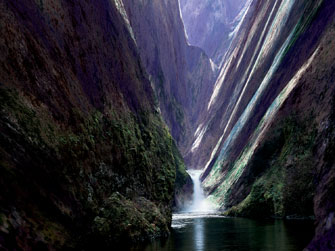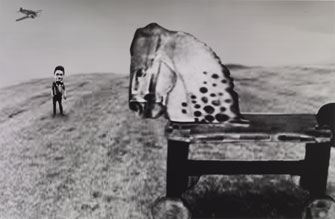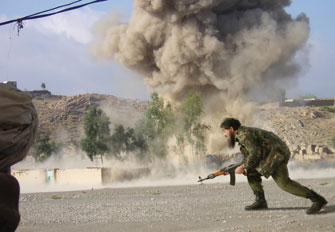True or False?
Let the Viewer Decide

“Orogenesis: Derain” (2004). © Joan Fontcuberta
Two intriguing exhibitions are currently showing at the Maison Européenne de la Photographie in Paris. One is a series of photographs by the filmmaker David Lynch, called “Small Stories.” The other is “Camouflages,” a mindboggling accumulation of photo series by the Catalan conceptual artist and photographer Joan Fontcuberta, winner of the 2013 Hasselblad award, who questions assumptions about reality with his own very special kind of storytelling.
On the top floor, Lynch explores his sometimes disquieting universe in about 40 surreal black-and-white images created especially for this show. Fixed images tell a story, says Lynch, and whether the story is long or short, it is inevitably determined by its spectator. What’s there is offered as raw material. You see in it what you see.
His method is to superimpose seemingly disparate images, one on top of another, using a sophisticated form of the trickery of ghost photography. One shows row of candles in a

“Thinking of Childhood.” © David Lynch. Courtesy Galerie Item, Paris
darkened seascape, with a small screen in the background displaying a weirdly disembodied head. In another, a naked child with the same weird head runs across a beach; superimposed over this image are a vintage car and two framed pictures. Interpret. Tell your own story.
Fontcuberta also says that his work is storytelling, but to make any sense of the story – and to appreciate this exhibition – you have to know what he’s about.
Fontcuberta obsessively questions notions of truth, sharpening the spectator’s critical senses by making up stories and then documenting them so thoroughly that they seem to become reality.
Here, he presents 10 projects, each nominally focused on a different subject: botany, zoology, geography, information and so on. “I wanted to make an alternative encyclopedia,” he says in an online interview. “I parody the way a subject uses photography – always trying to trick the spectator in the sense that an image is always fake.”
“Camouflages,” one of the projects in the exhibition, is scattered, or rather obtrusively “hidden,” amid the others. It consists of a series of apparently identical reproductions of a Goya portrait. Look closely, however, and you see that each apparently identical image has one identifying feature borrowed from the artist’s own body – his eyes, his hands, his nose. A playful statement of authorial omnipresence, it gives its name to the entire show.
To get into the spirit of the exhibition, look at the 10 or so autographed books displayed on the stairs leading to the basement space. According to Fontcuberta, there are three kinds of books here – some are real books that’s he’s published; some are written by other people who happen to have the same name; and some are pure spoofs. Real and unreal are not fixed opposites, he says.
The first room, titled “Fauna,” is given over to a parody of scientific discourse. The starting point is the work of a spoof German zoologist, Peter Ameisenhaufen, said to have spent his life in the first half of the 20th century searching the globe for exceptions to disprove the Darwinian theory of evolution. The resulting bestiary, worthy of the Middle Ages and replete with 12-pawed serpents and six-armed monkeys, demonstrates, Fontcuberta maintains, that science tells us only a temporary story, one way among others of expressing reality.
In the series “Spoutnik,” he recounts the imaginary story of a Soviet astronaut, Ivan Istochnikov, said to have disappeared in space in 1968, and the efforts of the Soviet authorities to cover up the disaster by airbrushing him out of history and sending his family to Siberia. A series of photos and documents chronicles his life and adventure in space. It is so convincingly realistic that, unless you know Fontcuberta’s work, you have no idea that the astronaut is the artist’s doppelganger, and Ivan Istochnikov is Russian for Joan Fontcuberta.
A hilarious series, “Déconstruire Oussama,” chronicles the adventures of two photographers from the agency Al-zur, based in Qatar. Mohammed Ben Kalish Ezab and

“Déconstruire Oussama”(2003). © Joan Fontcuberta
Omar Ben Salaad (the names are borrowed from Tintin) are on the trail of the chief of Al Qaeda. Doctor Fasquiyta, a mysterious person who often appears next to Bin Laden, is supposedly the brains of the organization. Guess whose face appears under the long beard and turban…
Whereas Lynch serves up quasi-Freudian angst, Fontcuberta offers an impish meditation on manipulation. Believe it or not.
La Maison Européenne de la Photographie: 5/7 rue de Fourcy, 75004 Paris. Métro: Saint Paul. Tel.: 01 44 78 75 00. Open Wednesday-Sunday, 11am-8pm. Admission: €8. Through March 16. www.mep-fr.org
Reader reaction: Click here to respond to this article (your response may be published on this page and is subject to editing).
Please support Paris Update by ordering books from Paris Update’s Amazon store at no extra cost. Click on your preferred Amazon location: U.K., France, U.S.
More reviews of Paris art shows.
© 2014 Paris Update
Favorite